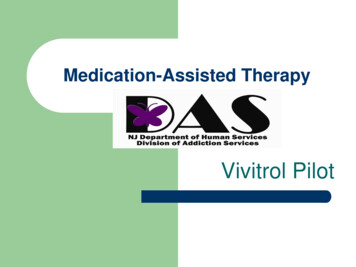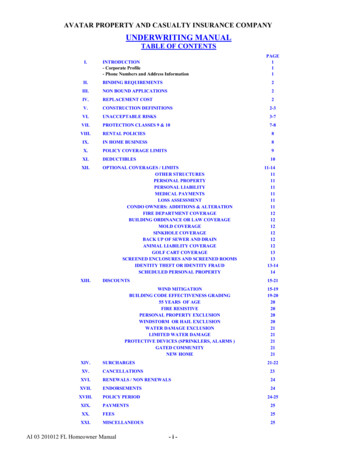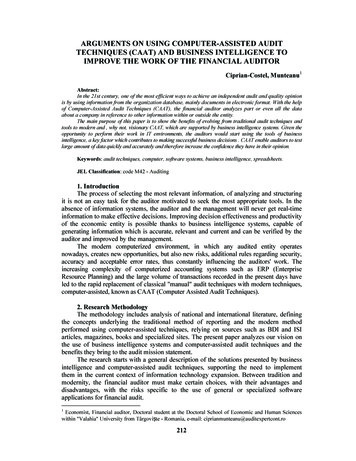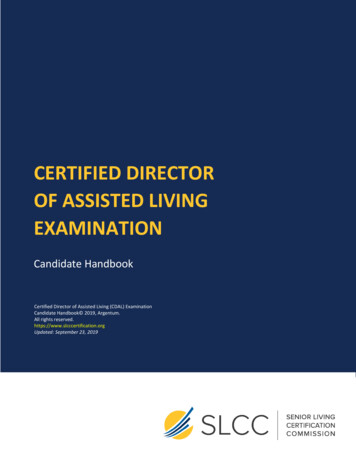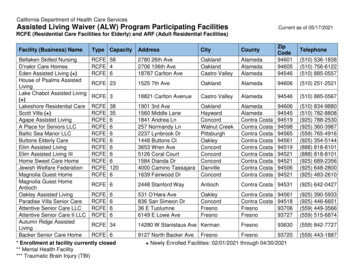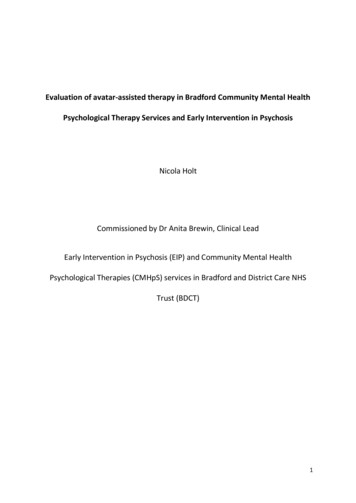
Transcription
Evaluation of avatar-assisted therapy in Bradford Community Mental HealthPsychological Therapy Services and Early Intervention in PsychosisNicola HoltCommissioned by Dr Anita Brewin, Clinical LeadEarly Intervention in Psychosis (EIP) and Community Mental HealthPsychological Therapies (CMHpS) services in Bradford and District Care NHSTrust (BDCT)1
Contents1. Introduction . 41.1 Background . 41.2 ProReal . 51.3 Service Context . 61.4 Aims. 72. Methods . 82.1 Questionnaires . 82.1.1 Participants . 82.1.2 Materials . 82.1.3 Procedure . 92.1.4 Analysis . 102.2 Focus Group . 102.2.1 Participants . 102.2.2 Materials . 102.2.3 Procedure . 102.2.4 Analysis . 113. Results . 133.1 Survey Data . 133.1.1 Sample Demographics . 133.1.2 Start-of-Therapy Questionnaire . 143.1.3 End of Therapy Questionnaire . 163.2 Focus Group . 183.2.1 Theme 1: What it adds . 183.2.2. Theme 2: Barriers . 203.2.3 Theme 3: Facilitators. 313.2.4 Theme 4: Safety . 324. Discussion. 342
4.1 Findings . 344.2 Limitations. 354.3 Recommendations . 364.4 Dissemination . 38References . 39Appendix 1: Pre- and Post-therapy Questionnaires . 43Appendix 2: ProReal Checklist . 483
1. Introduction1.1 BackgroundThe use of digital technologies in mental healthcare is a fast-growing area (Hollis et al., 2015).Opportunities are being explored through technologies such as electronic medical records (Perna,Grassi, Caldirola, & Nemeroff, 2018), outcome-prediction algorithms (Hannan et al., 2005),computerised self-help interventions (Richards & Richardson, 2012) and artificial intelligenceprograms (Luxton, 2014). Overall, the use of these technologies does show promise, often mosteffectively when used by skilled clinicians who can supplement them with human connection andflexibility.One emerging area is the use of virtual technologies as a tool for or adjunct to talking therapy.Programs such as the Second Life virtual world offer opportunities for replicating therapy settingsremotely (Rehm et al., 2016) although not without their own practical and ethical challenges(Quackenbush & Krasner, 2012). The use of virtual reality as a tool for interventions such as voicedialoguing, exposure therapy, social skills training, and so on has been found to be effective forvarious client groups, although not more so than other talking therapies (Fodor et al., 2018; Ghiţă &Gutiérrez-Maldonado, 2018; Gonçalves, Pedrozo, Coutinho, Figueira, & Ventura, 2012; Guillén,Baños, & Botella, 2018; Rus-Calafell, Garety, Sason, Craig, & Valmaggia, 2018).Avatar-assisted therapy similarly represents people’s experiences visually, but uses a screeninterface rather than an immersive experience. AVATAR therapy, in which clients with auditoryhallucinations represent their voices as avatars and practice interacting with them in more assertiveways, has been found to reduce the severity of auditory hallucinations (Rus-Calafell et al., 2018), andevidence from one single-blind randomised controlled trial suggests that it may offer similar butmore rapid, sustained improvements when compared with supportive counselling (Craig et al.,2018). Using avatars as part of face-to-face therapies has been reported to help with emotionrecognition and emotional expression and may offer the benefits of reduction of communication4
barriers; exploration of client identity through embodiment in an avatar; and manipulation andcontrol of treatment stimuli (Rehm et al., 2016).1.2 ProRealProReal (www.proreal.world) was designed as a therapeutic tool for counselling and coaching. Itoffers clients a virtual space to represent their experiences in either a blank or narrative-basedlandscape with several features such as cliff-edges, crossroads and fortresses. Users can set avatarsto different sizes, colours and postures, assign them emotions, thoughts and/or inner voices. Otherobjects are available (e.g. clocks, ticking time bombs, bridges) to help clients illustrate their innerworld. The landscape is interactive, and can be viewed from any avatar’s perspective, or from abroader ‘roaming’ view. Some examples from the software are shown in Figure 1. Therapists areencouraged to let clients take the lead in building their narrative worlds, and to be alongside ratherthan leading the session while using the software.Evidence supports the use of ProReal as an adjunct to talking therapy in a variety of settings. In twocase studies in a child and adolescent mental health service, reliable changes were found indepression scores after using ProReal, and idiosyncratic outcomes such as reduced number ofsuicidal thoughts and PTSD flashbacks were noted (Falconer, Davies, Grist, & Stallard, 2019). Bothclients were described as uncommunicative before therapy, and in interviews afterwards reportedfeeling better able to express themselves and communicate with their therapist without having totalk. Findings were similar in a school counselling setting with 29 pupils (van Rijn, Cooper, &Chryssafidou, 2018). Interviews suggested that change was achieved through developing insight andunderstanding about their difficulties; facilitating understanding for the counsellor, so they couldbetter help the young person; expressing and regulating emotions; increased self-acceptance andconfidence; making changes outside of sessions and monitoring these within the software; and thetherapeutic relationship. In adult settings, significant changes in outcome measures have not been5
demonstrated (Falconer et al., 2017; van Rijn, Cooper, Jackson, & Wild, 2017), but qualitativefindings suggest an overall positive response from clients. Participants described finding the systemmore powerful and impactful than non-avatar-based sessions (Falconer et al., 2017). There is someevidence that ProReal may accelerate change rather than improving outcomes overall. An analysisby Oxford Health NHS Foundation Trust estimated that this could save 20,000 per year of clinicians’time by reducing number of sessions needed to complete therapy (Janowska, 2019).Figure 1 Images from ProReal virtual world software1.3 Service ContextThis Service Evaluation Project (SEP) was commissioned by Dr Anita Brewin, clinical lead for the EarlyIntervention in Psychosis (EIP) and Community Mental Health Psychological Therapies (CMHpS)services in Bradford and District Care NHS Trust (BDCT). EIP works with people 14-65 years old whomay be experiencing mental health issues for the first time, particularly people having unusualexperiences typically associated with the onset of psychosis. They offer support for up to three years6
including psychological therapies, medical interventions, family support and wider support foractivities and daily living. CMHpS is part of the community mental health team for adults with severeand enduring mental health problems. Psychological therapists in both teams take referrals fromwithin their respective services.The focus for this SEP was the introduction and integration of the ProReal system into BDCT. Sevenpsychological therapists (2 from CMHpS, 2 from EIP, 1 who works across both teams, and 2 fromother teams within the Trust) were trained to use the system as part of the therapy they offer toclients. The evaluation followed them through their first year with access to the system.1.4 Aims To understand how therapists incorporate ProReal into their clinical work To assess the clinical utility of the ProReal system in BDCT To identify areas for further research7
2. MethodsThe evaluation was conducted between November 2018 and October 2019. Quantitativeinformation capturing therapists’ decision-making and their and clients’ experience of the system’susability and impact was collected using pre- and post-therapy questionnaires. Qualitativeinformation about their experiences was also collected at the end of the post-therapy questionnaire,and was supplemented with a focus group of therapists who had been using the system. Ethicalapproval for the evaluation was granted by the University of Leeds School of Medicine ResearchEthics Committee (SoMREC; reference DClinREC 18-02).2.1 Questionnaires2.1.1 ParticipantsAll therapists trained in the system were invited to take part. They were asked to invite all clientswith whom they used avatar-assisted therapy to take part.2.1.2 MaterialsThe pre-therapy questionnaire was completed by therapists for each client with whom they hadused the system. It asked for demographic information, details of the presenting problem(s) andtherapy model(s) used. Finally, therapists were asked to select factors which were involved in theirdecision to offer avatar-assisted therapy to this client, from a list of 8 options and a space to add‘other’ reasons. The options were developed through discussion with the SEP commissioners at thestart of the study period, based on reasons they were anticipating might be relevant in choosing whoto offer the new system to.8
The post-therapy questionnaire was completed by therapists and clients. This consisted of ameasure of ‘usability’, which both completed, and a measure of ‘impact’, which clients completed.These were adapted from the virtual and augmented reality (Manzoni et al., 2015) adaptation to theWorking Alliance Inventory (Horvath & Greenberg, 1989) to fit with the ProReal software. Space wasalso given for unstructured feedback on their thoughts and feelings about using the ProReal system.See Appendix 1 for the full content of both questionnaires.Therapists were also asked to keep a log with each client of their sessions, noting when and for howlong the avatar system was used.2.1.3 ProcedureThe lead researcher offered a meeting with all therapists trained in the system to introduce theevaluation, take their consent to take part, and explain the measures used. This was followed upwith monthly emails to check progress and request any questionnaires. Therapists completed thepre-therapy questionnaire at the start of their use of avatar-assisted therapy with each client. At theend of their therapy, or at the end of the study period if therapy was on-going, therapists completedthe post-therapy questionnaire. At this point, they also introduced the study to their client andinvited them to take part. If clients consented, they also completed a post-therapy questionnaire.Anonymised questionnaires were submitted by email or post to the lead researcher. The SEPcommissioner confirmed sight of all client consent forms, which were stored in clients’ notes withinthe service.9
2.1.4 AnalysisAs the sample size was anticipated to be small, the study lacked power for significance testingresults. Data are therefore presented descriptively, using percentages or averages whereappropriate.2.2 Focus Group2.2.1 ParticipantsAll therapists trained in the system were invited to take part in the focus group.2.2.2 MaterialsThe focus group was semi-structured and based around four topics:1. How useful has the system been for you clinically, and why?2. What was your experience of integrating the system into your clinical work?3. How have you found it using the system in this Trust, from a technological and/orlogistical viewpoint?4. What has been your experience of support, guidance and supervision in relation to usingthe system?2.2.3 ProcedureTherapists were invited by email to the focus group. Upon arrival they were provided with aninformation sheet and signed a consent form to take part. The focus group was audio-recorded, anda Leeds DClinPsy trainee was present to take notes in-vivo. The four topic questions were presented10
one at a time. Participants were encouraged to discuss the questions amongst themselves, withadditional questions from the facilitator where appropriate. All participants were assigned apseudonym.2.2.4 AnalysisThe focus group data was analysed using Thematic Analysis (TA, Braun & Clarke, 2006). The leadresearcher listened to the audio tape first to familiarise herself with the data, and then a secondtime in conjunction with the notes from the focus group to generate initial codes. These codes weresearched for emerging themes, which were then reviewed by checking their fidelity to the originaldata and their overall coherence as a thematic framework. After several iterations, a final thematicmap was arrived at. The themes were reviewed by another DClinPsy trainee who was shown twodraft versions of the thematic framework and asked to comment on which they felt best fit theparticipants’ responses. The main difference was the conceptualisation of ‘safety’ as integrated intothe other themes or a separate theme in itself. After discussion, both the author and fellow traineefelt that safety was one of the most important themes and so should be presented as a main theme.The report was also sent to the SEP commissioner, who was satisfied that the thematic frameworkrepresented the focus group discussion well.2.2.4.1 ReflexivityI was drawn to this SEP because I am interested in the ways that developing technology can assistand enhance clinical work. I have wondered whether new technologies add sufficient value toexisting clinical practice, or whether they can become more like gimmicks, bearing in mind that it isgenerally core clinical skills and relationship-building which have the biggest impact on therapy(Wampold, 2015), rather than the methods by which it is delivered. I was interested to see if theresults of this evaluation would help me answer those questions one way or another.11
Conversations I had throughout the course of the evaluation inevitably shaped my understanding ofhow people were finding it. Each therapist gave informal feedback when I met with them to takeconsent, and these conversations were the reason the focus group was added to the methodology:people’s experiences were not fully captured by the existing questionnaires. I also spoke to thecreators of the ProReal virtual world, who shared previous research and service evaluations. Again,these conversations influenced what I expected to find as themes within the focus group, and I madeefforts to balance creating space to explore these ideas and not trying to steer the conversation toomuch.12
3. Results3.1 Survey Data3.1.1 Sample DemographicsFour therapists and 18 clients provided data for the survey, giving a total of 35 questionnaires: 17start-of-therapy forms, 9 therapist end-of-therapy forms, and 9 client end-of-therapy forms. Thethree therapists who did not return surveys reported they had not been able to use ProReal enoughwith any clients to complete the questionnaires. Demographic data for clients is presented in Table1.Usage data was provided by 3 therapists for 12 clients, and shows that the avatar system was usedin an average of 78.6% of sessions per client (SD 35.3). For 8 of the clients the system was used inevery session. The average amount of each session dedicated to using the system was 59.1% (SD12.4).Table 1 Client sample characteristicsAverage Age33.5 (SD 11.2)Gender58.8% female41.2% maleEthnicity (as entered bytherapists)88.2% White British5.9% British Asian5.9% BME/BritishSexual Orientation64.7% heterosexual5.9% lesbian13
29.4% unknownEducation level11.8% GCSE11.8% A-Level/Higher29.4% Degree47.1% Unknown3.1.2 Start-of-Therapy QuestionnaireFigure 1 shows a summary of the start-of-therapy data. Presenting problems listed under ‘other’were physical health problems (n 2), Autism (n 1), ADHD (n 1), cognitive problems (n 1), grief/loss(n 1) and At Risk Mental State (n 1). The most common reason given for choosing to use avatarassisted therapy was to allow a ‘distancing’ which therapists hoped would help their clients see andreflect on their experiences. Least important to therapists was clients’ age and/or interest in digitaltechnology. Reasons given by therapists under ‘other’ related to: clients having difficultycommunicating verb
Evaluation of avatar-assisted therapy in Bradford Community Mental Health . Some examples from the software are shown in Figure 1. Therapists are . including psychological therapies, medical interventions, family support and wider support for activities and daily living. CMHpS is part o
